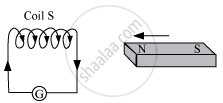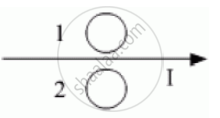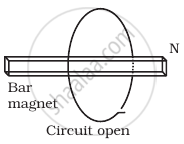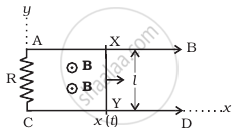Advertisements
Advertisements
प्रश्न
Show that Lenz's law is a consequence of conservation of energy.
उत्तर
According to Lenz law, the polarity of the induced emf is such that it opposes the change in magnetic flux responsible for its production.
Experiment:

When the bar magnet with its N-pole is moved towards the coil, the induced current produced in coil S opposes the motion of magnet. It will happen so, if the induced current in the coil S produces magnetic field lines from left to right i.e., if the induced current flows through the coil S in clockwise direction (when seen from left).
Lenz Law and Principle of Conservation of Energy

Lenz law is in accordance with the law of conservation of energy. In the above experiment, when N-pole of magnet is moved towards the coil, the right face of the coil acquires North polarity. Thus, work has to be done against the force of repulsion in bringing the magnet closer to the coil.
When N pole of magnet is moved away, South pole develops on the right face of the coil. Therefore, work has to be done against the force of attraction in taking the magnet away from the coil.
This mechanical work in moving the magnet with respect to the coil changes into electrical energy producing induced current. Hence, energy transformation takes place. Hence, we can say that Lenz's law is a consequence of conservation of energy.
APPEARS IN
संबंधित प्रश्न
Describe a simple experiment (or activity) to show that the polarity of emf induced in a coil is always such that it tends to produce a current which opposes the change of magnetic flux that produces it.
Predict the direction of induced current in the situation described by the following figure.

Predict the directions of induced currents in metal rings 1 and 2 lying in the same plane where current I in the wire is increasing steadily.

A pivoted aluminium bar falls much more slowly through a small region containing a magnetic field than a similar bar of an insulating material. Explain.
There are two coils A and B as shown in figure. A current starts flowing in B as shown, when A is moved towards B and stops when A stops moving. The current in A is counterclockwise. B is kept stationary when A moves. We can infer that ______.

Same as problem 4 except the coil A is made to rotate about a vertical axis (figure). No current flows in B if A is at rest. The current in coil A, when the current in B (at t = 0) is counterclockwise and the coil A is as shown at this instant, t = 0, is ______.

Consider a magnet surrounded by a wire with an on/off switch S (Figure). If the switch is thrown from the off position (open circuit) to the on position (closed circuit), will a current flow in the circuit? Explain.


A solenoid is connected to a battery so that a steady current flows through it. If an iron core is inserted into the solenoid, will the current increase or decrease? Explain.
A conducting wire XY of mass m and neglibile resistance slides smoothly on two parallel conducting wires as shown in figure. The closed circuit has a resistance R due to AC. AB and CD are perfect conductors. There is a ˆ. magnetic field `B = B(t)hatk`.

- Write down equation for the acceleration of the wire XY.
- If B is independent of time, obtain v(t) , assuming v(0) = u0.
- For (b), show that the decrease in kinetic energy of XY equals the heat lost in R.
